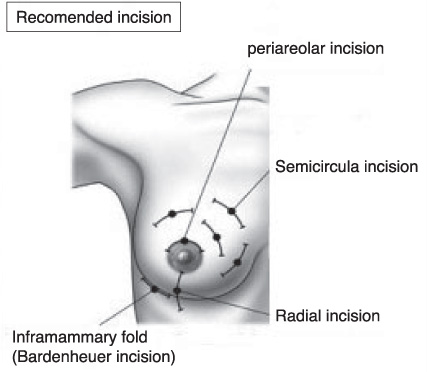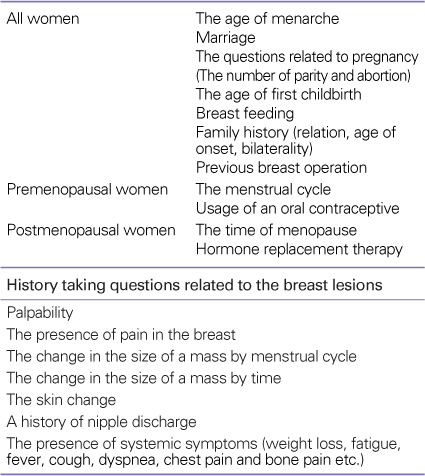 |
 |
- Search
| J Korean Med Assoc > Volume 52(10); 2009 > Article |
Abstract
Breast cancer is most common cancer in women in Korea from 2002. Early diagnosis is important to the treatment and the survival of patients. Clinical examination, imaging study, and pathologic examination are essential for diagnosis of breast cancer. Mammography and clinical breast examination have been widely used for screening. However, additional examination like ultrasonography is usually needed due to low sensitivity of mammography to the dense breast as found in many Korean women. The role of ultrasonography and MRI as a screening tool is controversial. Definite diagnosis of breast cancer is confirmed by pathologic review of breast tissue. A palpable lesion can be excised surgically or biopsied with fine-needle aspiration or core needle biopsy. Nonpalpable lesions can be excised surgically with needle localization or biopsied with core needle biopsy or vaccum assisted biopsy under radiologic guidance. For early detection and precise diagnosis of breast cancer, clinical history, physical examination, radiologic imaging and pathologic review should be balanced. The recommendations of screening and diagnostic tools for breast cancer are discussed in this article.
References
1. Lee SJ. 2006~2008 Breast cancer facts & figures 2008;Korean Breast Cancer Society.
2. Del Giudice ME, Tannenbaum D, Goodwin PJ. Breast self-examination: resistance to change. Can Fam Physician 2005;51:698-699.
3. Friis E. Breast self-examination is nt breast cancer screening. Ugeskr Laeger 2005;167:1872-1873.
4. Guth U, Huang DJ, Huber M, Schotzau A, Wruk D, Holzgreve W, Wight E, Zanetti-Dällenbach R. Tumor size and detection in breast cancer: Self-examination and clinical breast examination are at their limit. Cancer Detect Prev 2008;32:224-228.
5. Kaas R, Rutgers EJ. Systematic breast self-examination is not a useful screening procedure, except in hereditary or familial increased risk of breast cancer. Ned Tijdschr Geneeskd 2008;152:2317-2318.
6. Senie RT, Rosen PP, Lesser ML, Kinne DW. Breast self-examination and medical examination related to breast cancer stage. Am J Public Health 1981;71:583-590.
7. Smith EM, Francis AM, Polissar L. The effect of breast self-exam practices and physician examinations on extent of disease at diagnosis. Prev Med 1980;9:409-417.
8. Semiglazov VF, Manikhas AG, Moiseenko VM, Protsenko SA, Kharikova RS, Seleznev IK, Popova RT, Migmanova NSh, Orlov AA, Barash NIu, Ivanova OA, Ivanov VG. Results of a prospective randomized investigation [Russia (St.Petersburg)/WHO] to evaluate the significance of self-examination for the early detection of breast cancer. Vopr Onkol 2003;49:434-441.
9. McCready T, Littlewood D, Jenkinson J. Breast self-examination and breast awareness: a literature review. J Clin Nurs 2005;14:570-578.
10. O'Malley MS, Fletcher SW. US Preventive Services Task Force. Screening for breast cancer with breast self-examination. A critical review. JAMA 1987;257:2196-2203.
11. Semiglazov VF, Moiseenko VM. Breast self-examination for the early detection of breast cancer: a USSR/WHO controlled trial in Leningrad. Bull World Health Organ 1987;65:391-396.
12. Semiglazov VF, Moiseenko VM, Bavli Ia L, Migmanova N, Seleznev IK. Work experience of the WHO International Reference Center in assessing the effectiveness of self-examination for the early diagnosis of breast cancer (results of 2 years' research). Vopr Onkol 1988;34:969-974.
13. Semiglazov VF, Moiseenko VM, Manikhas AG, Protsenko SA, Kharikova RS, Popova RT, Migmanova NSh, Orlov AA, Barash NIu, Ivanova OA, Ivanov VG. Interim results of a prospective randomized study of self-examination for early detection of breast cancer (Russia/St.Petersburg/WHO). Vopr Onkol 1999;45:265-271.
14. Yoon HS. Nationwide Korean breast cancer data of 2002. J Korean Breast Cancer Soc 2004;7:72-83.
15. Chung SY, Han BK. Breast diagnostic imaging 2006;Seoul: Ilchokak.
17. Kerlikowske K, Grady D, Barclay J, Sickles EA, Ernster V. Likelihood ratios for modern screening mammography. Risk of breast cancer based on age and mammographic interpretation. JAMA 1996;276:39-43.
18. Kerlikowske K, Grady D, Barclay J, Sickles EA, Ernster V. Effect of age, breast density, and family history on the sensitivity of first screening mammography. JAMA 1996;276:33-38.
19. Liberman L, Morris EA, Benton CL, Abramson AF, Dershaw DD. Probably benign lesions at breast magnetic resonance imaging: preliminary experience in high-risk women. Cancer 2003;98:377-388.
20. Orel SG, Schnall MD. MR imaging of the breast for the detection, diagnosis, and staging of breast cancer. Radiology 2001;220:13-30.
21. Kolb TM, Lichy J, Newhouse JH. Comparison of the performance of screening mammography, physical examination, and breast US and evaluation of factors that influence them: an analysis of 27,825 patient evaluations. Radiology 2002;225:165-175.
22. Leconte I, Feger C, Galant C, Berliere M, Berg BV, D'Hoore W, Maldague B. Mammography and subsequent whole-breast sonography of nonpalpable breast cancers: the importance of radiologic breast density. AJR Am J Roentgenol 2003;180:1675-1679.
23. Berg WA, Gutierrez L, NessAiver MS, Carter WB, Bhargavan M, Lewis RS, Ioffe OB. Diagnostic accuracy of mammography, clinical examination, US, and MR imaging in preoperative assessment of breast cancer. Radiology 2004;233:830-849.
24. Kwak J, Kim E. The Usefulness of Additional Bilateral Whole Breast US with Negative Mammographic Results in Asymptomatic Women. J Korean Radiol Soc 2005;53:451-456.
25. Sampalis FS, Denis R, Picard D, Fleiszer D, Martin G, Nassif E, Sampalis JS. International prospective evaluation of scintimammography with (99m)technetium sestamibi. Am J Surg 2003;185:544-549.
26. Brem RF, Floerke AC, Rapelyea JA, Teal C, Kelly T, Mathur V. Breast-specific gamma imaging as an adjunct imaging modality for the diagnosis of breast cancer. Radiology 2008;247:651-657.
27. Giard RW, Hermans J. The value of aspiration cytologic examination of the breast. A statistical review of the medical literature. Cancer 1992;69:2104-2110.
28. Wollenberg NJ, Caya JG, Clowry LJ. Fine needle aspiration cytology of the breast. A review of 321 cases with statistical evaluation. Acta Cytol 1985;29:425-429.
29. O'Malley F, Casey TT, Winfield AC, Rodgers WH, Sawyers J, Page DL. Clinical correlates of false-negative fine needle aspirations of the breast in a consecutive series of 1,005 patients. Surg Gynecol Obstet 1993;176:360-364.
30. Elvecrog EL, Lechner MC, Nelson MT. Nonpalpable breast lesions: correlation of stereotaxic large-core needle biopsy and surgical biopsy results. Radiology 1993;188:453-455.
31. Gisvold JJ, Goellner JR, Grant CS, Donohue JH, Sykes MW, Karsell PR, Coffey SL, Jung SH. Breast biopsy: a comparative study of stereotaxically guided core and excisional techniques. AJR Am J Roentgenol 1994;162:815-820.
32. Dronkers DJ. Stereotaxic core biopsy of breast lesions. Radiology 1992;183:631-634.
- TOOLS
-
METRICS

-
Related articles in
J Korean Med Assoc -
Endoscopic diagnosis of early gastric cancer2022 May;65(5)
Epidemiology and diagnosis of inflammatory bowel diseases2021 September;64(9)
Biomarkers and diagnostic tools for lung cancer2021 January;64(1)
Hormone Replacement Therapy and the Risk of Breast Cancer2000 May;43(5)
Establishing Cancer Screening Recommendations for Major Cancers in Korea2002 August;45(8)








